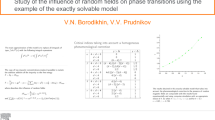Summary
As is well known, statistical ensembles of quantum systems, prepared through completely different physical procedures can correspond to the same density matrix and therefore cannot be distinguished by means of the average values on the ensemble of observables of the system. In this paper we introduce quantities which can be determined provided the ensemble can be identically reproduced and whose knowledge allows an unambiguous determination of the structure of the ensemble. In particular, general inequalities for these quantities are derived, which point out the intrinsic difference between mixtures of the first and of the second kind. The important fact is that, when the systems of the ensemble are part of larger quantum systems, the whole procedure can be developed without resorting to correlation experiments. For illustrative purposes the particular case of an ensemble of spin-1/2 particles is discussed in detail. The introduced procedure leads one to reconsider the problem of the homogeneity of ensembles and allows one to characterize it in a much more satisfactory way than is usually done. The concept of state is also discussed from the point of view of the present formalism.
Riassunto
Come ben noto, insiemi statistici di sistemi quantistici, preparati in modi fisicamente diversi, possono corrispondere alla stessa matrice densità e perciò non possono essere distinti con misure di valori medi di osservabili del sistema. In questo lavoro introduciamo delle quantità che possono essere determinate sperimentalmente con misure su insiemi identici e la cui conoscenza permette di determinare univocamente la composizione dell’insieme. In particolare si derivano diseguaglianze generali tra queste quantità che mettono in luce la profonda differenza tra miscele di prima e di seconda specie. Nel caso di miscele di seconda specie, l’intero procedimento può essere sviluppato senza far ricorso a misure di correlazione. Si discute in dettaglio il caso di un insieme di particelle di spin 1/2. Il procedimento introdotto porta a riconsiderare il problema dell’omogeneità degli insiemi permettendone una caratterizzazione particolarmente soddisfacente. Si discute anche del concetto di stato dal punto di vista del formalismo qui introdotto.
Резюме
Хорошо известно, что статистические ансамбли для квантовых систем, приготовленные с помощью совершенно различных физических операций, могут соответствовать одной и той же матрице плотности и, следовательно, их невозможно различить посредством средних значений по ансамблю наблюдаемых величин для рассматриваемой системы. В этой работе мы вводим величины, которые могут быть определены при условии, что ансамбль может быть тождественно воспроизведен, и знание которых позволяет однозначно определить структуру ансамбля. В частности, выводятся общие неравенства для этих величин, которые указывают на внутреннее различие между смешиваниями первого и второго рода. Важный результат состоит в том, что, когда системы ансамбля являются частями больших квантовых систем, то вся процедура может быть реализована, не прибегая к корреляционным экспериментам. Для иллюстративных целей подробно обсуждается частный случай ансамбля частиц со спином половина. Предложенная процедура приводит к рассмотрению проблемы однородности ансамблей и позволяет дать характеристику ансамблей более удовлетворительным образом по сравнению с тем, что делалось ранее. С точки зрения предложенного формализма также обсуждается концепция состояния.
Similar content being viewed by others
References
B. d’Espagnat:Conceptual Foundations of Quantum Mechanics (Menlo Park, Cal., 1971).
B. d’Espagnat: inPreludes in Theoretical Physics, edited byA. De-Shalit, H. Feshbach andL. Van Hove (Amsterdam, 1966), p. 185.
J. von Neumann:Mathematical Foundations of Quantum Mechanics (Princeton, N. J., 1955), p. 429.
D. Bohm:Quantum Theory (Englewood Cliff, N. J., 1951).
W. H. Furry: inLectures in Theoretical Physics, Vol.8 A, edited byW. E. Brittin (Boulder, Colo., 1966), p. 41.
J. M. Jauch:Helv. Phys. Acta,37, 293 (1964);Foundations of Quantum Mechanics (New York, N. Y., 1968);Rendiconti S.I.F., Course IL (New York, N. Y., 1971).
Author information
Authors and Affiliations
Additional information
Переведено редакцией.
Rights and permissions
About this article
Cite this article
Ghirardi, G.C., Rimini, A. & Weber, T. Is the density matrix description of statistical ensembles exhaustive?. Nuovo Cim B 29, 135–158 (1975). https://doi.org/10.1007/BF02732235
Received:
Published:
Issue Date:
DOI: https://doi.org/10.1007/BF02732235




